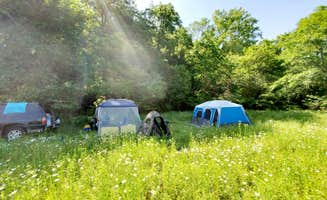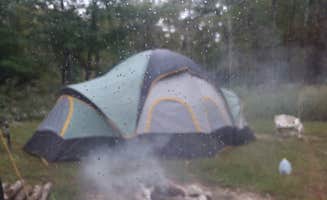Tent camping near Morrisville, Missouri offers primitive sites across several conservation areas in the Ozarks foothills. The region sits at approximately 1,100 feet elevation with rolling terrain and limestone outcroppings. Summer temperatures typically range from 70-90°F, while spring and fall camping seasons experience 40-70°F with varying precipitation. Most conservation area campgrounds require campers to be self-sufficient with limited amenities.
What to do
Water activities on river access points: At Fiery Fork Conservation Area, the river access provides excellent fly fishing opportunities from the bank or by wading in. "The river access is really amazing. It's a great place to launch a boat from or just to wade in a bit and fish," notes Amanda, adding that there's "quite a bit of 'beach' at the river access for them to play and see nature."
Wildlife viewing opportunities: Conservation areas around Morrisville support diverse wildlife viewing. According to Amanda's experience at Fiery Fork, "Armadillos, deer, and a few different bird types could be found easily." The less developed areas typically offer the best chances for wildlife encounters, especially during early morning or evening hours.
Hiking trails for varied skill levels: Busiek features multiple hiking trails with scenic river views. Josh S. reports, "I have been hiking here twice but haven't camped yet. The trails and the river make for some great scenery." He cautions that "water level can impact any hiking you might be looking to do, so be ready." Trail conditions vary seasonally with some routes becoming muddy after rainfall.
What campers like
Peace and quiet: Many conservation areas provide escape from urban noise. At Fiery Fork, Nick G. observed, "There were a few campers, but I'd be very surprised if this place isn't loud and packed in the summer." The more remote camping areas typically offer greater solitude, particularly during weekdays and non-holiday periods.
Free camping options: Swan Creek offers no-cost camping with creek access. David L. describes it as having "great dispersed camping, free, creek is accessible, has equestrian area to camp with horses, about 45 minutes to an hour from Springfield." Free sites typically lack developed amenities but provide more natural settings.
Hammock-friendly environments: The mature forest cover makes hammock camping viable at many sites. Whitney L. notes that Fiery Fork provides "good hammock trees, flat-level surface!" Similarly, Jenny D. describes the area having "lots of beautiful hammock friendly trees, river access, and creek beds to play in."
What you should know
Cell service limitations: Most conservation areas have minimal or no cellular coverage. At Fiery Fork, Erick H. cautions "be prepared to have no cell signal...had to drive a couple of miles for a signal. That is with Spectrum I believe they use Verizon." David L. confirms "No service for ATT" at Swan Creek. Emergency communication may require leaving the camping area.
Road access challenges: Gravel roads leading to campsites can be problematic for certain vehicles. According to Ry M., "The road down was very sketchy for my 2008 Mazda 3" at Fiery Fork. Some access roads may become impassable after heavy rain or during spring flooding, particularly at water crossings.
Pack-out trash requirements: Robert E. Talbot Conservation Area and other sites lack trash facilities. Wally B. observed at Fiery Fork that "much of the area was covered in trash. Bring extra trash bags!" No dumpsters are available at most conservation areas, requiring campers to transport all waste when departing.
Tips for camping with families
Accessible river play areas: Shallow water access points provide safe recreation for children. Amanda recommends Fiery Fork because "We decided it would be a nice place to bring our kids since there is quite a bit of 'beach' at the river access for them to play and see nature."
Bug protection essentials: Ticks and mosquitoes are prevalent, especially during warmer months. Linze K. recommends for Busiek: "Just make sure to bring the bug spray and tikis bc there are tons of bugs." Long pants, closed shoes, and regular tick checks are advisable when hiking with children.
Seasonal planning considerations: Some conservation areas close during hunting seasons or have restricted access. Eric O. experienced unexpected closure at Robert E. Talbot: "When we got there we found a locked gate across the entrance to the conservation area!" Check area regulations before trips, especially during fall hunting seasons.
Tips from RVers
Size restrictions for trailers: Most conservation area roads are not suitable for large RVs. Chrischelle N. advises for Fiery Fork: "I recommend smaller RVs due to the 2 miles of gravel and high water areas you go through to get there." Most sites accommodate vehicles under 25 feet, with primitive parking areas rather than developed RV pads.
Limited hookup availability: RV camping in conservation areas requires self-containment. While some sites like Fiery Fork allow RVs, Whitney L. noted neighbors "didn't hear a peep other than their generator for a bit." Most conservation areas lack water, electric, or sewer connections, making these locations best suited for boondocking-equipped RVs.



